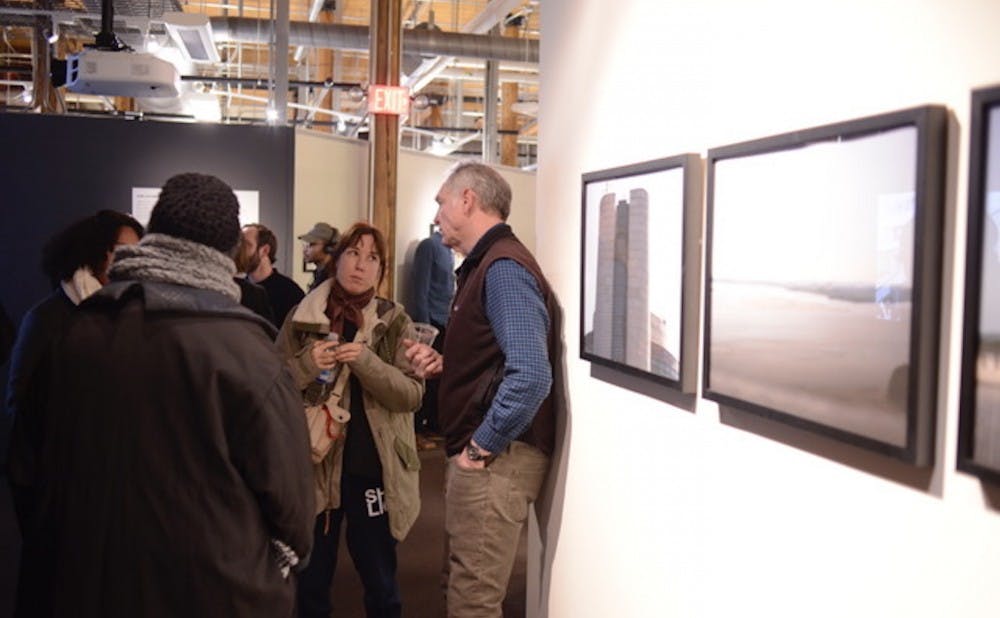Many people in the Western world have a rather vague and uncertain idea of what the demilitarized zone between North and South Korea looks like. Some know it simply as the world’s most dangerous border; others treat it as a reminder of the war that has persisted between the two neighboring countries for over 60 years. In the coming weeks, Duke students will be given an opportunity to explore the demilitarized zone from an insider’s perspective and develop their own view on the conflict that managed to divide one nation into two.
Beginning with an opening reception last Friday, the collaborative multimedia exhibition “Looking North” will be on display in the Smith Warehouse until Feb. 4. Assembled by Danny Kim, a student in the M.F.A. program in Experimental and Documentary Arts, and Peter Lisignoli, who graduated from the program in 2013, “Looking North” aims to create a realistic image of the Korean Demilitarized Zone by blending together vivid photographs, a multi-channel installation and a video game.
The project was born out of a coincidence. While finishing his thesis work in Korea, Danny Kim was introduced to Peter Lisignoli, an American filmmaker, who was deeply interested in the way the demilitarized zone functioned under the influence of war and propaganda. As a native Korean citizen, Kim had the opportunity to show Lisignoli a version of the world’s most dangerous border that was never meant to be seen by a Western tourist — the version that wasn’t prescribed or picturesque.

When Kim introduced Lisignoli to the demilitarized zone as he knew it, both artists were struck by inspiration and set out to document the reality that surrounded them. For this reason, “Looking North” is composed of the rich scenery of the farmland alongside scenes of gaping tourists coming in and out of gift shops and quiet announcements warning people about a heat wave.
“Each time I visited the area, I was struck by the idea that it was turned into an attraction site,” Kim said.
It quickly turned out he was not the only one who felt this way. After visiting the area, Lisignoli was also left with a feeling of displacement brought about by the contradictions between the past, present and future of the demilitarized zone.
“The most interesting thing about that place is different historical time periods that are expressed in the demilitarized zone. You learn about the past, you learn about the Korean war in the ‘50s and you are surrounded by these exhibits promising this kind of reunification in the future,” Lisignoli said. “Meanwhile, in the present we are still pretty much in the war zone.”
To present the demilitarized zone from an insider’s perspective, Kim and Lisignoli used various multimedia components. One of them is a video game that Kim programmed from scratch to enable his audience with a weapon that turns North Korean soldiers into K-pop lovers. (I personally “disarmed” five such soldiers while listening to some of the best Korean songs released in recent years.)

Another multimedia feature of the exhibition is a dual-channel video created by Lisignoli. This part of the project carefully portrays the conflicts that exist within the demilitarized zone as the video imagines the area’s future and reflects on its present condition. By using an engaging combination of sound, noise and visual elements, Lisignoli made the demilitarized zone come to life right in the middle of the showroom, 7,000 miles away from its actual territory.
However, the purpose of the exhibition does not solely revolve around documenting the current reality of the demilitarized zone, Kim said. Among other things, “Looking North” focuses on the idea that unlike Westerners, South Koreans are not afraid of their cousins in the North.
“I always find it really fascinating how the Western world is fearful of North Korea, but we live right below its border and move on with our daily lives,” Kim said.
He explained that for South Koreans, their Northern neighbors are not foes but rather long-lost relatives. In Kim’s photographs, when South Koreans look at the northern territory through telescopes, they try to imagine what the life down there might look like. They are longing for a chance to eliminate the secrecy that surrounds the North Korean land so their countries can be reunited after six decades of separation.
For now, as Kim and Lisignoli’s project points out, “looking north” is one of the only ways for South Koreans to feel connected to their northern counterparts while they are separated by different ideologies and borders.

The exhibition is now open and will be on display through Feb. 4 in the Smith Warehouse, Bay 11. The artist talk will take place Feb. 1 at 4:30 p.m.
Get The Chronicle straight to your inbox
Signup for our weekly newsletter. Cancel at any time.

